Audiation is the foundation of musical understanding. It describes the ability to hear – and understand! – music, even when music is not being played out loud. If you’ve ever gotten a song stuck in your head, congratulations – you know how to audiate!
The trick is to hone this skill beyond just hearing your favourite song in your head, so you can use it to better understand the music you hear and play.
In this article, I’m going to introduce you to the technique of singing basslines, a method that will lend you a better understanding of harmony while improving your sight singing, sight reading, and audiation skills – regardless of which instrument you play.
Harmonic Audiation
 We can audiate rhythmically, melodically, and harmonically.
We can audiate rhythmically, melodically, and harmonically.
Most musicians perform melody with a rhythm together in order to make their music.
However, if they are not aware of the underlying harmony – or, “the changes” – they are missing what famed composer Leonard Bernstein called “one third of music”.
If you were to hear the melody of a simple children’s song, would you know what chords to use to accompany the song on a piano or a guitar?
As audiators, we can train our musical brain to “hear the changes” by singing basslines.
Singing basslines is a technique from the pedagogy of Music Learning Theory, developed by Dr. Edwin E. Gordon. Music Learning Theory, or, MLT, attempts to explain how one learns music. One important aspect of learning music is to be able to audiate harmonically – if you’re not hearing harmonic changes when you’re listening to music, you’re not fully audiating.
An excellent place to start with harmonic audiation is with basslines that lie beneath the melodies you know and love.
Why Sing Basslines?
The bassline usually contains the important notes that define the harmony. If you can sing a bassline, and you can identify the function of the note you are singing, you are well on your way to being able to audiate harmonically.
Singing, meanwhile, is a direct connection to your audiation. It is the connection between your musical thoughts and your external music production. When we sing, the sound immediately goes back into our ears, and we check for accuracy – it is a very important loop in the music education process.
Singing basslines, rather than just playing them, is the perfect way to relate them to melody and to internalize harmony. Generally, if you can sing it, you can play it on your instrument – which makes it a great place to start.
Hearing one thing while singing another is challenging for musicians to do at first. However, a good learning guideline: if it’s challenging to one’s musicianship, then it’s worth working on!
Start with I and V
Even though you may be an advanced technical musician, let’s start very simply with the tonic and dominant – that is, the I and V chords – in major and minor. We will use melodies from familiar folk tunes that only use I and V chords as the basis of their harmonic structure. Thankfully, as we’re about to see, there are plenty.
Tonic and Dominant harmonic functions (also known as I and V, respectively) are the foundations of harmony in Western music. They provide context for the melody.
We can use moveable-do solfege to assist us in identifying tonic and dominant, grounding our audiation. This means “do” to represent the tonic, and “so” for the dominant.
Major Tonality
In major tonality, a tonic chord (I) is any combination of “do”, “mi”, and “so”. You can hear these all at once, as in when you strum a chord on the guitar, or you can hear them individually in an arpeggio.
A dominant chord (V) is any combination of “so”, “fa”, “re”, and “ti”.
Music Learning Theory teachers teach their students tonic and dominant patterns, which are varying arpeggiated combinations of tonic and dominant chords, and for good reason: patterns are the words of music. By learning tonal patterns, you are learning a vocabulary of musical words that you can use in a myriad of ways. You can improvise with those words; you can read them; you can write them.
Here are tonic and dominant patterns in major tonality. Try singing these patterns. To hear these tonic and dominant patterns, you can watch these videos.
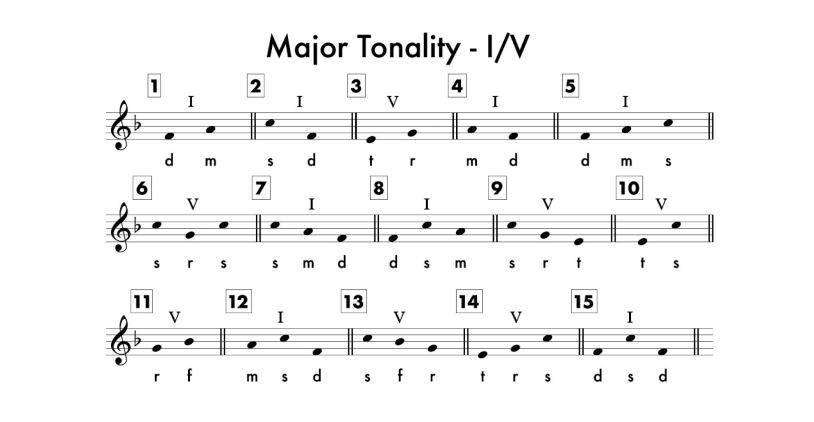
Minor Tonality
In minor tonality, a tonic chord (i) is any combination of “la”, “do”, and “mi”. A dominant chord (V) is any combination of “mi”, “re”, “ti”, and “si”.
Here are tonic and dominant patterns in minor tonality. Try singing these patterns:
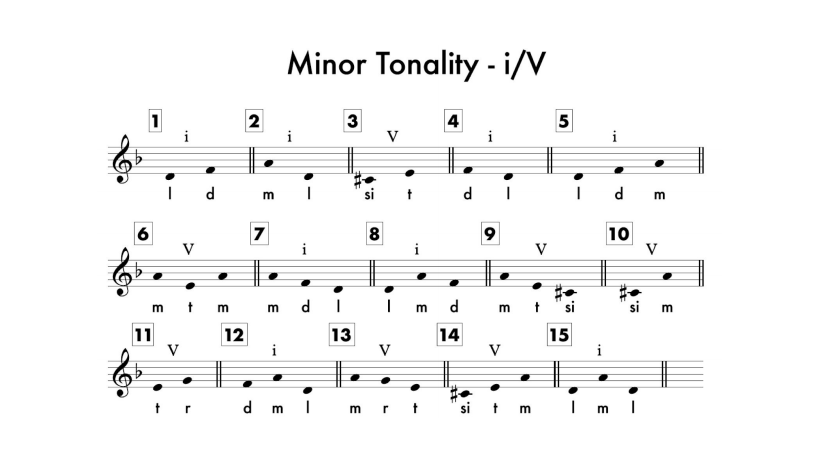
Connecting I and V
Once we can successfully audiate tonic and dominant chords, it is a good idea to find the pathways between the two harmonic functions. Again, we can use solfege to assist us.
These two videos show the various ways that we can connect tonic and dominant chords in major and minor:
Singing Basslines Video Series
Once we have a firm grasp of tonic and dominant and how they function, we can sing the basslines of each chord to drastically improve our musicianship.
To give my students practice singing basslines outside of my classroom, I have created some YouTube videos with practice exercises. These YouTube videos follow these steps:
- Listen to the melody of a familiar tune. This first video uses the folk chestnut, “Skip To My Lou.”
- Listen again, and hum along with the tune. Ask yourself if you hear the harmonic changes that accompany the tune. Do you hear where the I and V should go? If not, then this video series is definitely for you!
- Hum along again. This time, I will add the bassline. Tune your ears to both parts. When the bassline changes notes, this indicates a harmonic change.
- After you are comfortable with that, “bum” along with the bassline in whatever octave feels comfortable. You will be hearing two parts simultaneously – the melody and the bassline.
- Next, add a verbal association. This gives your brain a label for the sound. I use the words “one” and “five” on the pitches “do” (tonic) and “so” (dominant).
- Finally, alternate between singing the melody while listening to the bassline, and singing the bassline while listening to the melody. Do each one three times. Begin by singing the melody.
Follow the same steps for the rest of the tunes in this playlist.
If you play the piano or the guitar, you may want to try playing the melody on your instrument while singing the bassline. Then switch, and try playing the bassline while singing the melody.
Here is the musical notation for several more songs in Major and Minor with only I and V harmony.


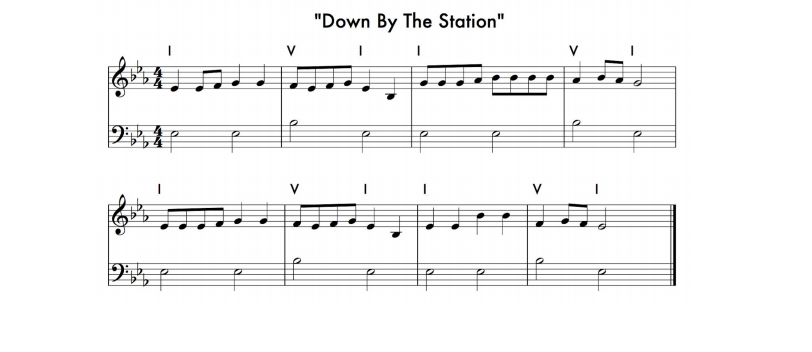
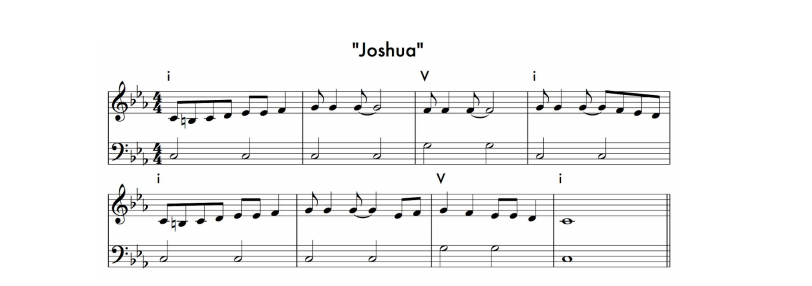
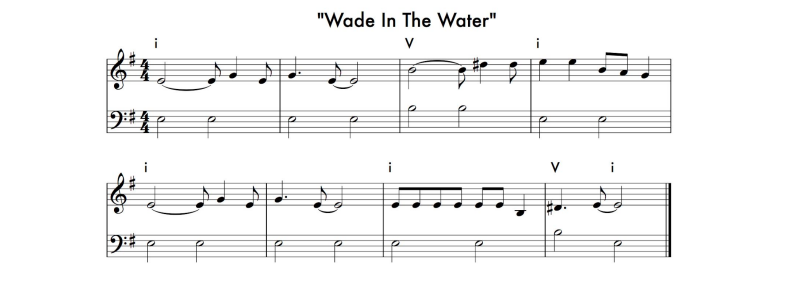
Considerations
When doing these exercises, there are several factors you should be thinking about, related to the song of choice and your singing voice.
Range
 Typically, the bassline falls into the range of an adult male singer. However, displacing the pitch by one octave will not decrease the effectiveness of this exercise. You will still be tuning into the harmonic changes in a very powerful way.
Typically, the bassline falls into the range of an adult male singer. However, displacing the pitch by one octave will not decrease the effectiveness of this exercise. You will still be tuning into the harmonic changes in a very powerful way.
Is This Really a Bassline?
While playing through some of the exercises above, you may be wondering: are these even basslines? Technically, yes and no. It could be a bassline, but a very simple one. Most basslines contain notes other than the root, somewhat resembling melodies themselves. This exercise, however, is intended to focus your attention on the harmonic changes. After we learn the foundational notes in the bass that outline the harmonic changes, the other notes will be much easier.
Moving Forward with Harmony
Once you have mastered humming or singing the bassline to songs with a I and V harmonic structure, it’s time to challenge yourself further.
How? Try adding in more harmonies. There are plenty of songs that have I, IV and V as the basis of their harmonic structure – the 12-bar blues are a fantastic example for beginners, with a predictable and easily-audible progression.
Understanding harmony is part of a bigger musical picture – harmonic changes are the backbone of great songs, and with an understanding of harmony under your belt, you’ll be able to analyze chord changes in songs to see why they pack such a punch, and even use the principles of harmony to write your own music with movement, emotion, tension, and depth.
Harmony is a massively important part of music, and there are many ways to attune your ear to hearing it. The next time you’re listening to music, tune your ear into the chord movements and the feelings that they lend to songs – it’s like getting a behind-the-scenes peek into your favourite music.
The post Singing Basslines to Improve Musicianship appeared first on Musical U.
